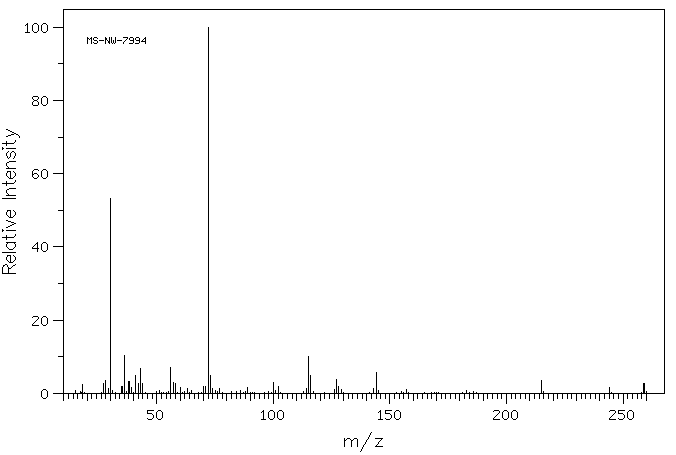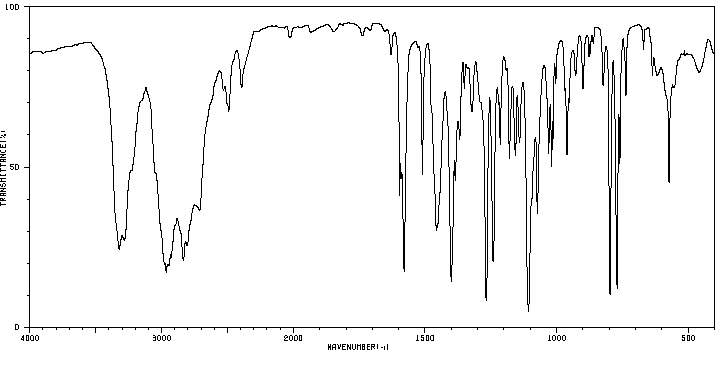盐酸普萘洛尔 | 318-98-9
-
物化性质
-
计算性质
-
ADMET
-
安全信息
-
SDS
-
制备方法与用途
-
上下游信息
-
文献信息
-
表征谱图
-
同类化合物
-
相关功能分类
-
相关结构分类
物化性质
-
熔点:163-165 °C(lit.)
-
闪点:9℃
-
溶解度:H2O:50 mg/mL,澄清,无色
-
颜色/状态:White or almost white powder
-
气味:Odorless
-
味道:Bitter
-
稳定性/保质期:
Propranolol hydrochloride preparations should be protected from light and storedat room temperature (approximately 25 °C). The manufacturer recommends that propranolol hydrochloride extended-release capsules be stored in tight, light resistant containers and be protected from moisture, freezing, and excessive heat. USP recommends that propranolol hydrochloride preparations be stored in well closed containers. Solutions of the drug have maximum stability at pH 3 and decompose rapidly at alkaline pH. Decomposition in aqueous solution is accompanied by a lowered pH and discoloration. Propranolol hydrochloride injection is reportedly compatible with 0.9% sodium chloride injection; however, specialized references should be consulted for specific compatibility information.
-
分解:When heated to decomposition it emits toxic fumes of oxides of nitrogen.
-
解离常数:pKa = 9.45
计算性质
-
辛醇/水分配系数(LogP):3.0
-
重原子数:20
-
可旋转键数:6
-
环数:2.0
-
sp3杂化的碳原子比例:0.38
-
拓扑面积:41.5
-
氢给体数:3
-
氢受体数:3
ADMET
安全信息
-
危险等级:IRRITANT
-
危险品标志:Xn
-
安全说明:S22
-
危险类别码:R22
-
WGK Germany:3
-
海关编码:2933990090
-
危险品运输编号:NONH for all modes of transport
-
RTECS号:UB7525000
-
危险标志:GHS07
-
危险性描述:H302
-
储存条件:2-8°C
SDS
模块 1. 化学品
1.1 产品标识符
: (±)-Propranolol hydrochloride
产品名称
1.2 鉴别的其他方法
无数据资料
1.3 有关的确定了的物质或混合物的用途和建议不适合的用途
仅用于研发。不作为药品、家庭或其它用途。
模块 2. 危险性概述
2.1 GHS-分类
急性毒性, 经口 (类别 4)
2.2 GHS 标记要素,包括预防性的陈述
象形图
警示词 警告
危险申明
H302 吞咽有害。
警告申明
预防措施
P264 操作后彻底清洁皮肤。
P270 使用本产品时不要进食、饮水或吸烟。
事故响应
P301 + P312 如果吞咽并觉不适: 立即呼叫解毒中心或就医。
P330 漱口。
废弃处置
P501 将内容物/ 容器处理到得到批准的废物处理厂。
2.3 其它危害物 - 无
模块 3. 成分/组成信息
3.1 物 质
: C16H21NO2 · HCl
分子式
: 295.8 g/mol
分子量
组分 浓度或浓度范围
[2-Hydroxy-3-(naphthyloxy)propyl]isopropylammonium chloride
<=100%
化学文摘登记号(CAS 318-98-9
No.) 206-268-7
EC-编号
模块 4. 急救措施
4.1 必要的急救措施描述
一般的建议
请教医生。 向到现场的医生出示此安全技术说明书。
吸入
如果吸入,请将患者移到新鲜空气处。 如呼吸停止,进行人工呼吸。 请教医生。
皮肤接触
用肥皂和大量的水冲洗。 请教医生。
眼睛接触
用水冲洗眼睛作为预防措施。
食入
切勿给失去知觉者通过口喂任何东西。 用水漱口。 请教医生。
4.2 主要症状和影响,急性和迟发效应
心博徐缓, 低血压, 呼吸困难, 呼吸暂停, 呕吐, 腹泻, 干燥的嘴唇, 肌肉无力
4.3 及时的医疗处理和所需的特殊处理的说明和指示
无数据资料
模块 5. 消防措施
5.1 灭火介质
灭火方法及灭火剂
用水雾,抗乙醇泡沫,干粉或二氧化碳灭火。
5.2 源于此物质或混合物的特别的危害
碳氧化物, 氮氧化物, 氯化氢气体
5.3 给消防员的建议
如必要的话,戴自给式呼吸器去救火。
5.4 进一步信息
无数据资料
模块 6. 泄露应急处理
6.1 作业人员防护措施、防护装备和应急处置程序
使用个人防护用品。 避免粉尘生成。 避免吸入蒸气、烟雾或气体。 保证充分的通风。 避免吸入粉尘。
6.2 环境保护措施
不要让产品进入下水道。
6.3 泄漏化学品的收容、清除方法及所使用的处置材料
收集和处置时不要产生粉尘。 扫掉和铲掉。 放入合适的封闭的容器中待处理。
6.4 参考其他部分
丢弃处理请参阅第13节。
模块 7. 操作处置与储存
7.1 安全操作的注意事项
避免接触皮肤和眼睛。 避免形成粉尘和气溶胶。
在有粉尘生成的地方,提供合适的排风设备。
7.2 安全储存的条件,包括任何不兼容性
贮存在阴凉处。 使容器保持密闭,储存在干燥通风处。
建议的贮存温度: 2 - 8 °C
保存在干燥处。
7.3 特定用途
无数据资料
模块 8. 接触控制和个体防护
8.1 容许浓度
最高容许浓度
没有已知的国家规定的暴露极限。
8.2 暴露控制
适当的技术控制
根据良好的工业卫生和安全规范进行操作。 休息前和工作结束时洗手。
个体防护设备
眼/面保护
带有防护边罩的安全眼镜符合 EN166要求请使用经官方标准如NIOSH (美国) 或 EN 166(欧盟)
检测与批准的设备防护眼部。
皮肤保护
戴手套取 手套在使用前必须受检查。
请使用合适的方法脱除手套(不要接触手套外部表面),避免任何皮肤部位接触此产品.
使用后请将被污染过的手套根据相关法律法规和有效的实验室规章程序谨慎处理. 请清洗并吹干双手
所选择的保护手套必须符合EU的89/686/EEC规定和从它衍生出来的EN 376标准。
完全接触
物料: 丁腈橡胶
最小的层厚度 0.11 mm
溶剂渗透时间: 480 min
测试过的物质Dermatril® (KCL 740 / Z677272, 规格 M)
飞溅保护
物料: 丁腈橡胶
最小的层厚度 0.11 mm
溶剂渗透时间: 480 min
测试过的物质Dermatril® (KCL 740 / Z677272, 规格 M)
, 测试方法 EN374
如果以溶剂形式应用或与其它物质混合应用,或在不同于EN
374规定的条件下应用,请与EC批准的手套的供应商联系。
这个推荐只是建议性的,并且务必让熟悉我们客户计划使用的特定情况的工业卫生学专家评估确认才可.
这不应该解释为在提供对任何特定使用情况方法的批准.
身体保护
全套防化学试剂工作服, 防护设备的类型必须根据特定工作场所中的危险物的浓度和数量来选择。
呼吸系统防护
如须暴露于有害环境中,请使用P95型(美国)或P1型(欧盟 英国
143)防微粒呼吸器。如需更高级别防护,请使用OV/AG/P99型(美国)或ABEK-P2型 (欧盟 英国 143)
防毒罐。
呼吸器使用经过测试并通过政府标准如NIOSH(US)或CEN(EU)的呼吸器和零件。
模块 9. 理化特性
9.1 基本的理化特性的信息
a) 外观与性状
形状: 粉末
b) 气味
无数据资料
c) 气味阈值
无数据资料
d) pH值
无数据资料
e) 熔点/凝固点
熔点/凝固点: 163 - 165 °C
f) 沸点、初沸点和沸程
无数据资料
g) 闪点
无数据资料
h) 蒸发速率
无数据资料
i) 易燃性(固体,气体)
无数据资料
j) 高的/低的燃烧性或爆炸性限度 无数据资料
k) 蒸气压
无数据资料
l) 蒸汽密度
无数据资料
m) 密度/相对密度
无数据资料
n) 水溶性
无数据资料
o) n-辛醇/水分配系数
无数据资料
p) 自燃温度
无数据资料
q) 分解温度
无数据资料
r) 粘度
无数据资料
模块 10. 稳定性和反应活性
10.1 反应性
无数据资料
10.2 稳定性
无数据资料
10.3 危险反应
无数据资料
10.4 应避免的条件
无数据资料
10.5 不相容的物质
强氧化剂, 强酸
10.6 危险的分解产物
其它分解产物 - 无数据资料
模块 11. 毒理学资料
11.1 毒理学影响的信息
急性毒性
半数致死剂量 (LD50) 经口 - 大鼠 - 466 mg/kg
皮肤刺激或腐蚀
无数据资料
眼睛刺激或腐蚀
无数据资料
呼吸道或皮肤过敏
无数据资料
生殖细胞致突变性
无数据资料
致癌性
IARC:
此产品中没有大于或等于 0。1%含量的组分被 IARC鉴别为可能的或肯定的人类致癌物。
生殖毒性
生殖毒性 - 兔子 - 静脉内的
对生殖的影响:交配能力(例如#交配成功雌性每#交配的雌性;#交配每#发情周期)。
对生殖的影响:胚胎植入前死亡率(例如每个雌性的植入胚胎数减少;每个黄体的植入总数。
对生殖的影响:其他生殖力相关检测。
生殖毒性 - 人 - 雌性 - 经口
对新生儿的影响:其他新生儿检测或影响。 对新生儿的影响:生化与代谢。
发育毒性 - 大鼠 - 移植
对胚胎或胎儿的影响:其他对胚胎的影响。 特定发育异常:呼吸系统。
特异性靶器官系统毒性(一次接触)
无数据资料
特异性靶器官系统毒性(反复接触)
无数据资料
吸入危险
无数据资料
潜在的健康影响
吸入 吸入可能有害。 可能引起呼吸道刺激。
摄入 误吞对人体有害。
皮肤 通过皮肤吸收可能有害。 可能引起皮肤刺激。
眼睛 可能引起眼睛刺激。
接触后的征兆和症状
心博徐缓, 低血压, 呼吸困难, 呼吸暂停, 呕吐, 腹泻, 干燥的嘴唇, 肌肉无力
附加说明
化学物质毒性作用登记: UB7525000
模块 12. 生态学资料
12.1 生态毒性
无数据资料
12.2 持久性和降解性
无数据资料
12.3 潜在的生物累积性
无数据资料
12.4 土壤中的迁移性
无数据资料
12.5 PBT 和 vPvB的结果评价
无数据资料
12.6 其它不良影响
无数据资料
模块 13. 废弃处置
13.1 废物处理方法
产品
将剩余的和不可回收的溶液交给有许可证的公司处理。
与易燃溶剂相溶或者相混合,在备有燃烧后处理和洗刷作用的化学焚化炉中燃烧
受污染的容器和包装
按未用产品处置。
模块 14. 运输信息
14.1 联合国危险货物编号
欧洲陆运危规: - 国际海运危规: - 国际空运危规: -
14.2 联合国运输名称
欧洲陆运危规: 非危险货物
国际海运危规: 非危险货物
国际空运危规: 非危险货物
14.3 运输危险类别
欧洲陆运危规: - 国际海运危规: - 国际空运危规: -
14.4 包裹组
欧洲陆运危规: - 国际海运危规: - 国际空运危规: -
14.5 环境危险
欧洲陆运危规: 否 国际海运危规 国际空运危规: 否
海洋污染物(是/否): 否
14.6 对使用者的特别提醒
无数据资料
模块 16. 其他信息
进一步信息
版权所有:2013 Co. LLC. 公司。许可无限制纸张拷贝,仅限于内部使用。
上述信息视为正确,但不包含所有的信息,仅作为指引使用。本文件中的信息是基于我们目前所知,就正
确的安全提示来说适用于本品。该信息不代表对此产品性质的保证。
参见发票或包装条的反面。
模块 15 - 法规信息
N/A
制备方法与用途
白色或乳白色结晶性粉末,无臭且微甜后苦。在物理性质方面,普萘洛尔在常温下稳定;其盐酸盐熔点为163-164℃。干燥失重和溶解性:易溶于甲醇、稍易溶于水、冰乙酸及乙醇,微溶于氯仿,极难溶于乙醚、苯或乙酸乙酯,在稀酸中侧链会氧化分解;碱性条件下则保持稳定,且左旋体多于右旋体。在使用外消旋体时需特别注意。
药理作用- 普萘洛尔是一种非选择性的β肾上腺素受体阻滞剂,通过阻断心脏上的β1和β2受体,拮抗交感神经兴奋及儿茶酚胺的作用,从而降低心脏的收缩力与速度。它减慢了传导系统的传导速度,并减弱心脏对运动或刺激的反应,进而减少心肌耗氧量、增加运动耐力,用于治疗心绞痛。
- 该药物可以抑制心脏起搏点的电位兴奋性,治疗心律失常;同时通过中枢神经元阻滞和降低肾素释放及减少心排出量的作用,达到治疗高血压的效果。
- 普萘洛尔能竞争性地拮抗异丙肾上腺素与去甲肾上腺素的作用,阻断β2受体,从而抑制血浆肾素活性。这可能导致支气管痉挛、胰岛素分泌减少以及血糖升高等现象。
- 具有显著的抗血小板聚集作用,这是由于其膜稳定效应及对血小板膜Ca²⁺转运的抑制。
- 盐酸普萘洛尔片:口服后胃肠道吸收完全,在肝脏内广泛代谢,生物利用度约为30%,肝病患者慎用。大约1小时到1.5小时内达到血药浓度峰值,消除半衰期为2至3小时,血浆蛋白结合率为90%-95%。个体间的血药浓度差异显著,表观分布容积平均值为(3.9±6.0)L/kg。该药物主要通过肾脏排泄,大部分是代谢产物,仅有少量(小于1%)原形物。
- 盐酸普萘洛尔注射液:与血浆蛋白结合率为93%,静脉注射后半衰期约为2至3小时,主要经肾脏排泄,为代谢产物,极小部分以原形排出。
1-萘酚和环氧氯丙烷发生烃基化反应生成 3-(1-萘氧基)-1,2-环氧丙烷;随后与异丙胺开环生成普萘洛尔;最后通过盐酸处理形成盐酸普萘洛尔。
生物活性Propranolol HCl(AY-64043,ICI-45520,NCS-91523)是一种竞争性且非选择性的β肾上腺素受体抑制剂,IC50值为12 nM。
靶点| Target | Value |
|---|---|
| β-adrenergic receptor | 12 nM |
用途:用于治疗各种功能性心律失常、室上性和室性异位期外收缩、心房纤维颤动及麻醉引起的不齐。
反应信息
-
作为反应物:描述:参考文献:名称:Solution and Mixing Thermodynamics of Propranolol and Atenolol in Aqueous Media摘要:基于 van't Hoff 和 Gibbs 方程,根据测定的溶解度值评估了普萘洛尔 (PPN) 和阿替洛尔 (ATN) 在 pH=11.5 的水中混合时的溶解热力学函数吉布斯能、焓和熵。在几个温度下。 ATN 获得的平衡溶解度值几乎是 PPN 的三百倍。两种药物的溶出焓均为正值,而溶出熵均为负值,表明药物溶出过程后分子组织更大。另外,在两种情况下混合熵也为负,表明混合熵正在驱动药物溶出过程。从溶质-溶剂相互作用,特别是疏水水合方面讨论了结果。DOI:10.1007/s10953-008-9348-1
-
作为产物:描述:1-bromo-3-(1-naphthyloxy)-2-propanone 在 sodium tetrahydroborate 、 甲烷 作用下, 以 甲醇 、 5,5-dimethyl-1,3-cyclohexadiene 、 乙醇 为溶剂, 反应 6.5h, 生成 盐酸普萘洛尔参考文献:名称:一种盐酸普萘洛尔的制备方法摘要:本发明属于医药化工领域,尤其涉及一种盐酸普萘洛尔的制备方法,包括以下步骤:步骤1:1‑萘酚在氢氧化钠溶液中与1,3‑二溴(碘)丙酮反应,生成1‑溴(碘)‑3‑(1‑萘氧基)‑2‑丙酮;步骤2:1‑溴(碘)‑3‑(1‑萘氧基)‑2‑丙酮在有机溶剂中被硼氢化钠还原,生成1‑溴(碘)‑3‑(1‑萘氧基)‑2‑丙醇;步骤3:1‑溴(碘)‑3‑(1‑萘氧基)‑2‑丙醇在有机溶剂中与异丙胺反应,生成1‑异丙氨基‑3‑(1‑萘氧基)‑2‑丙醇;步骤4:1‑异丙氨基‑3‑(1‑萘氧基)‑2‑丙醇与盐酸成盐,生成盐酸普萘洛尔,该方法避免了环氧氯丙烷的使用,更为安全环保,反应过程中没有含环氧乙烷结构的中间体,用药安全性更高。公开号:CN108586273B
文献信息
-
1,5-Substituted indol-2-yl amide derivatives申请人:Nettekoven Matthias公开号:US20070123515A1公开(公告)日:2007-05-31The present invention relates to compounds of formula I wherein R 1 to R 4 and G are as defined in the description and claims and pharmaceutically acceptable salts thereof. The compounds are useful for the treatment and/or prevention of diseases which are associated with the modulation of H3 receptors.本发明涉及式I的化合物,其中R1至R4和G如描述和索赔中定义的,并且其药学上可接受的盐。这些化合物可用于治疗和/或预防与H3受体调节相关的疾病。
-
INDOL-2-YL-PIPERAZIN-1-YL-METHANONE DERIVATIVES申请人:Nettekoven Matthias公开号:US20080188484A1公开(公告)日:2008-08-07The present invention relates to compounds of formula I wherein A and R 1 to R 4 are as defined in the description and claims, and pharmaceutically acceptable salts thereof. The compounds are useful for the treatment and/or prevention of diseases which are associated with the modulation of H3 receptors.本发明涉及公式I的化合物,其中A和R1至R4如描述和声明中所定义,并且其药学上可接受的盐。这些化合物可用于治疗和/或预防与H3受体调节相关的疾病。
-
BENZOFURAN AND BENZOTHIOPHENE-2-CARBOXYLIC ACID AMIDE DERIVATIVES申请人:Mohr Peter公开号:US20090029976A1公开(公告)日:2009-01-29The present invention relates to compounds of formula I wherein X, A and R 1 to R 4 are as defined in the description and claims, and pharmaceutically acceptable salts thereof. The compounds are useful for the treatment and/or prevention of diseases which are associated with the modulation of H3 receptors.本发明涉及公式I的化合物,其中X,A和R1至R4如描述和索赔中所定义,并且其药学上可接受的盐。这些化合物可用于治疗和/或预防与H3受体调节相关的疾病。
-
[EN] NITROGEN RING CONTAINING COMPOUNDS FOR TREATMENT OF INFLAMMATORY DISORDERS<br/>[FR] COMPOSÉS CONTENANT UN CYCLE AZOTÉ POUR LE TRAITEMENT DE TROUBLES INFLAMMATOIRES申请人:WEINGARTEN M DAVID公开号:WO2012135669A1公开(公告)日:2012-10-04The invention provides compounds, pharmaceutical compositions and methods of treatment of inflammatory disorders including a compound of Formula I, or its pharmaceutically acceptable salt, ester, pharmaceutically acceptable derivative or prodrug wherein R1, R2, R3, R4, X, Y, W, Z and Q are as defined herein.这项发明提供了化合物、药物组合物和治疗炎症性疾病的方法,包括式I的化合物,或其药用可接受的盐、酯、药用可接受的衍生物或前药,其中R1、R2、R3、R4、X、Y、W、Z和Q如本文所定义。
-
Dibenzylamine compound and medicinal use thereof申请人:Maeda Kimiya公开号:US20050059810A1公开(公告)日:2005-03-17A dibenzylamine compound represented by the formula (1) wherein R 1 and R 2 are each a C 1-6 alkyl group optionally substituted by halogen atoms and the like; R 3 , R 4 and R 5 are each a hydrogen atom, a halogen atom and the like, or R 3 and R 4 may form, together with carbon atoms bonded thereto, a homocyclic or heterocyclic ring optionally having substituent(s); A is —N(R 7 ) (R 8 ) and the like; ring B is an aryl group or a heterocyclic residue; R 6 is a hydrogen atom, a halogen atom, a nitro group, a C 1-6 alkyl group and the like; n is an integer of 1 to 3, a prodrug thereof and a pharmaceutically acceptable salt thereof show selective and potent CETP inhibitory activity, and therefore, they can be provided as therapeutic or prophylactic agents for hyperlipidemia or arteriosclerosis and the like.
表征谱图
-
氢谱1HNMR
-
质谱MS
-
碳谱13CNMR
-
红外IR
-
拉曼Raman
-
峰位数据
-
峰位匹配
-
表征信息








